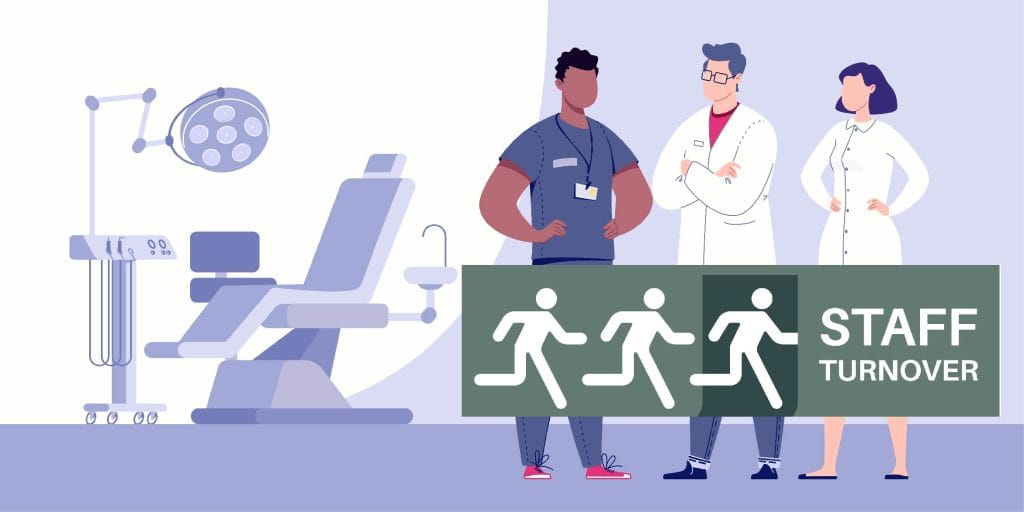 If you’re a dentist, chances are you’ve thought about breaking free from insurance companies. The endless write-offs, the limitations on treatment, the constant headaches—it’s no wonder so many dentists are eager to ditch insurance plans and transition to a fee-for-service (FFS) model.
If you’re a dentist, chances are you’ve thought about breaking free from insurance companies. The endless write-offs, the limitations on treatment, the constant headaches—it’s no wonder so many dentists are eager to ditch insurance plans and transition to a fee-for-service (FFS) model.
But here’s the hard truth: while many dentists say they want to drop insurance; most aren’t willing to put in the work needed to make it happen successfully. The desire alone isn’t enough. If you want to make this change, you need to roll up your sleeves and dive into the numbers.
Step 1: Change Your Mindset—But Don’t Stop There
 The first step is deciding you’re done with insurance. That’s a powerful move, but it’s just the beginning. The real challenge is doing the groundwork to ensure your practice can thrive without insurance reimbursement. And that means tackling the often-overlooked task of analytics.
The first step is deciding you’re done with insurance. That’s a powerful move, but it’s just the beginning. The real challenge is doing the groundwork to ensure your practice can thrive without insurance reimbursement. And that means tackling the often-overlooked task of analytics.
It’s easy to get caught up in the excitement of going fee-for-service, but if you don’t understand the financial impact of dropping insurance, you’re setting yourself up for a rough transition. This is where most dentists fall short: they make the decision but skip the critical preparation.
Step 2: Do the Hard Work of Analyzing Your Numbers
Let’s be real—doing a deep dive into your practice’s analytics isn’t glamorous. It takes time, effort, and a willingness to confront uncomfortable truths about your current financial setup. But it’s the only way to ensure that dropping insurance is a smart move for your practice.
Here’s what you need to do:
 First, you need a clear picture of your office’s fee schedule versus what insurance plans are paying you. Review how many patients you’ve seen from each insurance plan over the past year and calculate how much revenue they’re generating. It’s one thing to say insurance is costing you money, but you need hard data to back that up.
First, you need a clear picture of your office’s fee schedule versus what insurance plans are paying you. Review how many patients you’ve seen from each insurance plan over the past year and calculate how much revenue they’re generating. It’s one thing to say insurance is costing you money, but you need hard data to back that up.
Then, dig into your write-offs. Take a close look at specific procedures like crowns, fillings, and cleanings. Are you giving up 20%, 30%, or even more on each treatment because of insurance discounts? Many dentists are shocked when they see the numbers in black and white. This analysis can be eye-opening, but it’s also the wake-up call you need to make informed decisions.
What Does “Fee-for-Service” Really Mean?
Now, you may be thinking, “Jeff, this all sounds daunting and I still feel like this is going to destroy my practice.”
Well, fee-for-service doesn’t mean you are rejecting insurance outright. It simply means you receive your full, regular fee for services provided.
Under a PPO, a crown might bring in $800, but with FFS, you’d get the full $1,300. And yes, you can still accept assignment where it makes sense. If a patient comes from a PPO background and chooses to stay with you after you drop their plan, they pay their out-of-pocket portion front, and you can still accept their insurance’s out-of-network benefits.
Or, if you really want to fully divest from insurances, you can choose not to accept assignment, meaning the patient will pay the full cost of treatment and then personally submit for reimbursement on their own.
Either way, it’s straightforward and lets you keep more of what you earn.
The Numbers Might Shock You
Look at the numbers! It’s all about the financials.
When done properly, most of our clients lose less than 30% of their existing patients when dropping an insurance plan. And most offices don’t even need to get more new fee-for-service patients to offset this because now they are being paid their full fee.
Let me give you an example of how this might work:
Say 3 patients need crowns that are in a PPO. You get $800 x 3 = $2,400.
If you dropped that plan, and lost 30% of those patients (1 in this example) you still have 2 left paying your full fee.
So that would be $1,300 x 2 = $2,600.
You actually made more money while paying less in lab costs and overhead than before with less patients!
 Now, imagine you’re producing $160,000 in services but only collecting $100,000 because of PPO write-offs. You still incur all the costs of $160,000 production.
Now, imagine you’re producing $160,000 in services but only collecting $100,000 because of PPO write-offs. You still incur all the costs of $160,000 production.
Your lab and supply company don’t give you a “PPO discount.” Your staff doesn’t ask for 40% less pay when you’re treating PPO patients.
Carrying 100% of the costs for 60% of the income simply is not very sustainable, and it makes growth nearly impossible.
If you want to see how much a plan is costing you, we have a Free Insurance Plan Analyzer, that lets you plug in your numbers and it will show you exactly how much each plan is costing you and how many fee-for-service new patients you would need to offset this loss (if any).
This is a very thorough analyzer so if you need any help going through it, feel free to reach out to me at Jeffs@mgeonline.com and I can go through it with you.
Ready to Put in the Work? We’re Here to Help
If you’re serious about dropping insurance but don’t know where to start with the analytics, you don’t have to do it alone. At MGE Management Experts, we’ve helped thousands of dentists make this transition—but only those who are willing to do the work.
 We’re offering a Free Practice Analysis to guide you through the process. Together, we’ll evaluate your data, identify the weak spots, and create a strategic plan to help you transition smoothly.
We’re offering a Free Practice Analysis to guide you through the process. Together, we’ll evaluate your data, identify the weak spots, and create a strategic plan to help you transition smoothly.
Click here to schedule your Free Analysis today!
Dropping insurance isn’t for the faint of heart. But if you’re willing to put in the effort to analyze your numbers, you can reclaim control of your practice, increase your profitability, and build a thriving, patient-focused business.
Conclusion
Dentists often dream of breaking free from insurance, but few are willing to do the hard work it takes to get there. Don’t be one of them. Start with your data, dig deep into your analytics, and make decisions based on facts, not just feelings. That’s the only way to ensure a smooth, profitable transition to fee-for-service.
And, like always, if you need help with this subject at all, schedule that analysis and I will make sure this is the right move for your practice and guide you through the process. I look forward to speaking with you!
Feel free to call us if you have any questions at (800) 640-1140 or email me at Jeffs@mgeonline.com



No Comments
Be the first to start a conversation